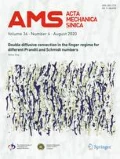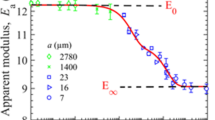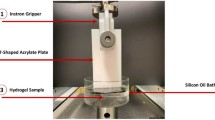Abstract
Hydrogels, three-dimensional hydrophilic polymer networks, are appealing candidate materials for studying the cellular microenvironment as their substantial water content helps to better mimic soft tissue. However, hydrogels can lack mechanical stiffness, strength, and toughness. Composite hydrogel systems have been shown to improve upon mechanical properties compared to their singlecomponent counterparts. Poly (ethylene glycol) dimethacrylate (PEGDMA) and alginate are polymers that have been used to form hydrogels for biological applications. Singlecomponent and composite PEGDMA and alginate systems were fabricated with a range of total polymer concentrations. Bulk gels were mechanically characterized using spherical indentation testing and a viscoelastic analysis framework. An increase in shear modulus with increasing polymer concentration was demonstrated for all systems. Alginate hydrogels were shown to have a smaller viscoelastic ratio than the PEGDMA gels, indicating more extensive relaxation over time. Composite alginate and PEGDMA hydrogels exhibited a combination of the mechanical properties of the constituents, as well as a qualitative increase in toughness. Additionally, multiple hydrogel systems were produced that had similar shear moduli, but different viscoelastic behaviors. Accurate measurement of the mechanical properties of hydrogels is necessary in order to determine what parameters are key in modeling the cellular microenvironment.

Similar content being viewed by others
References
Hoffman, A.S.: Hydrogels for biomedical applications. Annals of the New York Academy of Sciences 944, 62–73 (2001)
Ratner, B.D., Hoffman, A.S.: Synthetic hydrogels for biomed ical applications. In Hydrogels for Medical and Related Applications, ACS Symposium Series 31, 1–36 (1976)
Shapiro, J.M., Oyen, M.L.: Hydrogel composite materials for tissue engineering scaffolds. JOM 65, 1–12 (2013)
Lutolf, M.P., Hubbell, J.A.: Synthetic biomaterials as instructive extracellular microenvironments for morphogenesis in tissue engineering. Nature Biotechnology 23, 47–55 (2005)
Engler, A.J., Sen, S., Sweeney, H.L., et al.: Matrix elasticity directs stem cell lineage specification. Cell 126, 677–689 (2006)
Trappmann, B., Gautrot, J.E., Connelly, J.T., et al.: Extracellular-matrix tethering regulates stem-cell fate. Nature Materials 11, 642–649 (2012)
Oyen, M.L.: Mechanical characterisation of hydrogel materials. International Materials Reviews 59, 44–59 (2014)
Baroli, B.: Hydrogels for tissue engineering and delivery of tissue-inducing substances. Journal of Pharmaceutical Sciences 96, 2197–2223 (2007)
Rowley, J.A., Madlambayan, G., Mooney, D.J.: Alginate hydrogels as synthetic extracellular matrix materials. Biomaterials 20, 45–53 (1999)
Burdick, J.A., Anseth, K.S.: Photoencapsulation of osteoblasts in injectable RGD-modified PEG hydrogels for bone tissue engineering. Biomaterials 23, 4315–4323 (2002)
Zhu, J.: Bioactive modification of poly (ethylene glycol) hydrogels for tissue engineering. Biomaterials 31, 4639–4546 (2010)
Galli, M., Comley, K.S.C., Shean, T.A.V., et al.: Viscoelastic and poroelastic mechanical characterization of hydrated gels. Journal of Materials Research 24, 973–979 (2009)
Draget, K.I., Østgaard, K., Smidsrød, O.: Homogeneous alginate gels: A technical approach. Carbohydrate Polymers 14, 159–178 (1990)
Johnson, K.L.: Contact Mechanics. Cambridge University Press, Cambridge (1985)
Oyen, M.L.: Analytical techniques for indentation of viscoelastic materials. Philosophical Magazine 86, 5625–5641 (2006)
Mattice, J.M., Lau, A.G., Oyen, M.L., et al.: Spherical indentation load-relaxation of soft biological tissues. Journal of Materials Research 21, 2003–2010 (2006)
Lee, E.H., Radok, J.R.M.: The contact problem for viscoelastic bodies. Journal of Applied Mechanics 27, 438–444 (1960)
Discher, D.E., Janmey, P., Wang, Y.L.: Tissue cells feel and respond to the stiffness of their substrate. Science 310, 1139–1143 (2005)
Discher, D.E., Mooney, D.J., Zandstra, P.W.: Growth factors, matrices, and forces combine and control stem cells. Science 324, 1673–1677 (2009)
Lutolf, M.P., Raeber, G.P., Zisch, A.H., et al.: Cell-responsive synthetic hydrogels. Advanced Materials 15, 888–892 (2003)
Oyen, M.L.: Poroelastic nanoindentation responses of hydrated bone. Journal of Materials Research 23, 1307–1314 (2008)
Oyen, M.L., Shean, T.A.V., Strange, D.G.T., et al.: Size effects in indentation of hydrated biological tissues. Journal of Materials Research 27, 245–255 (2011)
Hu, Y., Zhao, X., Vlassak, J.J., et al.: Using indentation to characterize the poroelasticity of gels. Applied Physics Letters 96, 121904 (2010)
Cha, C., Kim, S.Y., Cao, L., et al.: Decoupled control of stiffness and permeability with a cell-encapsulating poly(ethylene glycol) dimethacrylate hydrogel. Biomaterials 31, 4864–4871 (2010)
Yonet-Tanyeri, N., Rich, M.H., Lee, M., et al.: The spatiotemporal control of erosion and molecular release from micropatterned poly(ethylene glycol)-based hydrogel. Biomaterials 34, 8416–8423 (2013)
Strange, D.G.T.: Mechanics of biomimetic materials for tissue engineering of the intervertebral disc, [PhD. Thesis]. University of Cambridge, Cambridge (2013)
LeRoux, M.A., Guilak, F., Setton, L.A.: Compressive and shear properties of alginate gel: Effects of sodium ions and alginate concentration. Journal of Biomedical Materials Research 47, 46–53 (1999)
Strange, D.G.T., Oyen, M.L.: Composite hydrogels for nucleus pulposus tissue engineering. Journal of the Mechanical Behavior of Biomedical Materials 11, 16–26 (2012)
Purslow, P.P. Measurement of the fracture toughness of extensible connective tissues. Journal of Materials Science 18, 3591–3598 (1983)
Author information
Authors and Affiliations
Corresponding author
Rights and permissions
About this article
Cite this article
Shapiro, J.M., Oyen, M.L. Viscoelastic analysis of single-component and composite PEG and alginate hydrogels. Acta Mech Sin 30, 7–14 (2014). https://doi.org/10.1007/s10409-014-0025-x
Received:
Revised:
Accepted:
Published:
Issue Date:
DOI: https://doi.org/10.1007/s10409-014-0025-x




